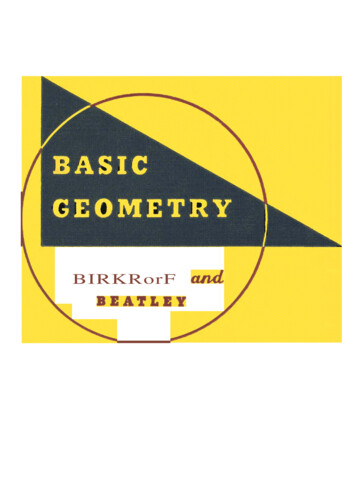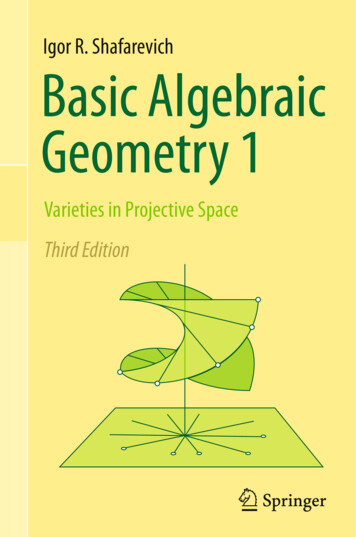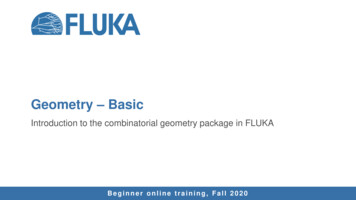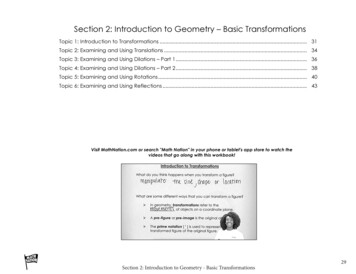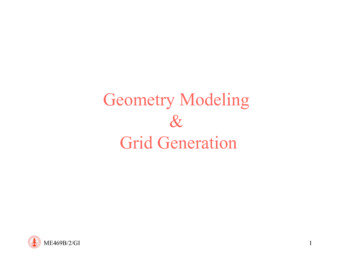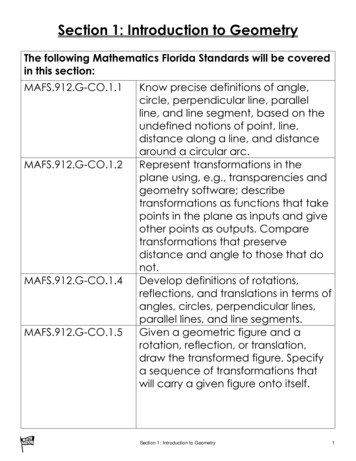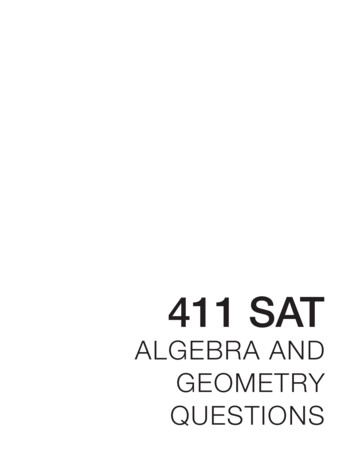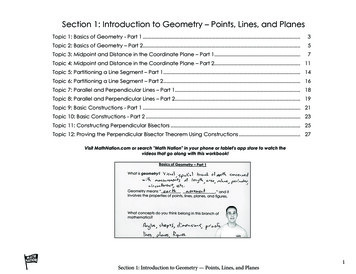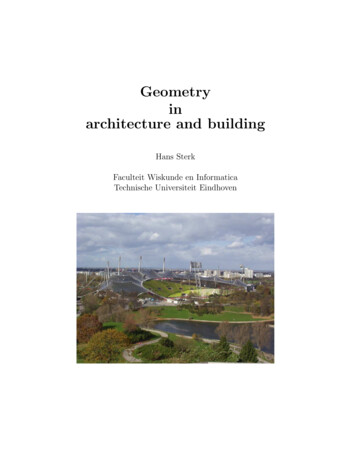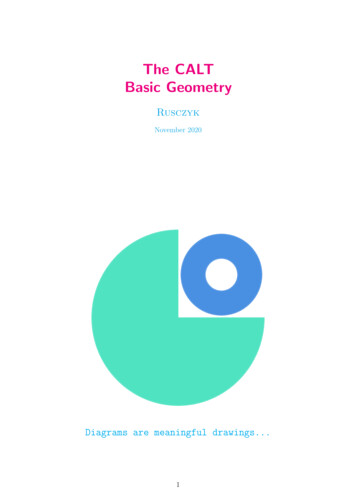
Transcription
The CALTBasic GeometryRusczykNovember 2020Diagrams are meaningful drawings.1
The CALTBasic GeometryRusczykContents1 Introduction1.1 Why Bother? . . . . . . . .1.2 Quadrilaterals . . . . . . . .1.2.1 Square . . . . . . . . .1.2.2 Rectangle . . . . . . .1.2.3 Parallelogram . . . . .1.2.4 Trapezoid . . . . . . .1.2.5 Kite . . . . . . . . . .1.3 Triangles . . . . . . . . . . .1.3.1 Equilateral Triangle .1.3.2 Isosceles Triangle . . .1.3.3 Scalene Triangle . . . .1.3.4 Obtuse Triangles . . .1.3.5 Acute Triangles . . . .1.3.6 Right Angle Triangles1.4 Circular Figures . . . . . . .1.5 Polygons . . . . . . . . . . .2 Pythagorean Theorem2.1 Brief History and Derivation2.2 The Theorem . . . . . . . .2.3 Proving the Theorem . . . .2.4 Pythagorean Triplets . . . .2.5 Special Triangles . . . . . .2.5.1 45 - 45 - 90 . . . . . .2.5.2 30 - 60 - 90 . . . . . .2.6 Problems . . . . . . . . . . .333344566677889912.1313131415161616173 A few Examples184 Exercises202
The CALTBasic GeometryRusczyk§1 Introduction§1.1 Why Bother?Now, why should we bother to find the area or the perimeter of a random figure whichbarely has any meaning to us. Well, there is one reason for it, you are made up fromshapes, you live in shapes, you draw with shapes, you write with shapes and.So, to conclude, shapes are everywhere, and that is why we have to knowhow to measure them.So, lets do a quick overview of how to calculate the area and perimeter of basic shapesand then we will move on to a few funky ones.§1.2 QuadrilateralsOkay, so what are quadrilaterals? Well, quadrilaterals are figures with 4 sides. Here area few basic quadrilaterals that you ought to know:§1.2.1 SquareHere is a square:Lets look over a few properties of a square:1. All four sides of a square are same length, they are equal:2. Opposite side of a square are parallel3. All four angles of a square are right angles:4. Sum of the angles of a square are equal to 360 degrees:5. Diagonal of a square are same length:6. Each diagonal of a square divides its into two equal symmetrical areaFormulaArea of a Square: s2Perimeter of a Square: 4s3
The CALTBasic GeometryRusczyk§1.2.2 RectangleHere is a rectangle:Lets look over a few properties of a rectangle:1. A rectangle is a quadrilateral2. The opposite sides are parallel and equal to each other3. Each interior angle is equal to 90 degrees4. The diagonals bisect each other5. Both the diagonals have the same lengthFormulaArea of a Rectangle: lbPerimeter of a Rectangle: 2(l b)§1.2.3 ParallelogramHere is a parallelogram:Lets look over a few properties of a parallelogram:1. The opposite sides are congruent.2. The opposite angles are congruent.3. The consecutive angles are supplementary.4
The CALTBasic GeometryRusczyk4. If anyone of the angles is a right angle, then all the other angles will be the rightangle.5. The two diagonals bisect each other.6. Each diagonal bisects the parallelogram into two congruent triangles.FormulaArea of a Parallelogram: bhPerimeter of a Parallelogram: 2(a b)§1.2.4 TrapezoidHere is a trapezoid:Lets look over a few properties of a Trapezoid:1. The properties of trapezoid apply by definition (parallel bases).2. The legs are congruent by definition.3. The lower base angles are congruent.4. The upper base angles are congruent.5. Any lower base angle is supplementary to any upper base angle.6. The diagonals are congruent.FormulaArea of a Trapezoid:b1 b2 h2Perimeter of a Trapezoid: b1 b2 m n5
The CALTBasic GeometryRusczyk§1.2.5 KiteHere is a Kite:Lets look over a few properties of a Kite: Two pairs of sides known as consecutive sides are equal in length. One pair of diagonally opposite angles is equal in measurement. These angles aresaid to be congruent with each other. The diagonals meet each other at 90 , this means that they form a perpendicularbisection.FormulapqArea of a Kite:2where p and q are diagonals.Perimeter of a Kite: 2a 2b§1.3 TrianglesTriangles are figures which have 3 sides. They can be classified based on angles andlengths of sides. Lets look at a few triangles:§1.3.1 Equilateral TriangleHere is an equilateral Triangle:Lets look over a few properties of an Equilateral Triangle: All sides are of equal length. All medians are of equal length6
The CALTBasic GeometryRusczyk All interior angles are 60 It is a regular polygonFormulaArea of an Equilateral Triangle: 3 2s4Perimeter of an Equilateral Triangle: 3s§1.3.2 Isosceles TriangleHere is an isosceles triangle:Lets look over a few properties of an Isosceles Triangle: Two sides are congruent to each other. The third side of an isosceles triangle which is unequal to the other two sides iscalled the base of the isosceles triangle. The two angles opposite to the equal sides are congruent to each other. That meansit has two congruent base angles and this is called an isosceles triangle base angletheorem. The angle which is not congruent to the two congruent base angles is called anapex angle. The altitude from the apex of an isosceles triangle bisects the base into two equalparts and also bisects its apex angle into two equal angles. The altitude from the apex of an isosceles triangle divides the triangle into twocongruent right-angled triangles.§1.3.3 Scalene TriangleHere is a scalene triangle:7
The CALTBasic GeometryRusczykLets look over a few properties of a Scalene Triangle: It has no equal sides. It has no equal angles. It has no line of symmetry. It has no point symmetry. The angles inside this triangle can be an acute, obtuse or right angle.§1.3.4 Obtuse TrianglesHere is an obtuse triangle:Lets look over a few properties of an Obtuse Triangle: The longest side of an obtuse triangle is the one opposite the obtuse angle vertex. An obtuse triangle may be either isosceles (two equal sides and two equal angles)§1.3.5 Acute TrianglesHere is an acute triangle:Lets look over a few properties of an Acute Triangle: All equilateral triangles are acute triangles. Any triangle in which the Euler line is parallel to one side is an acute triangle. Acute triangles can be isosceles, equilateral, or scalene. The longest side of an acute triangle is opposite the largest angle.8
The CALTBasic GeometryRusczyk§1.3.6 Right Angle TrianglesHere is a right angle triangle:Lets look over a few properties of a Right Angle Triangle: The sum of all three interior angles is 180 . The larger interior angle is the one included by the two legs, which is 90 . The sum of the two smaller interior angles is 90 Uses the Pythagorean Theorem which states that a2 b2 c2FormulaArea of a Right Angle Triangle:ab2Perimeter of a Right Angle Triangle: a b c§1.4 Circular FiguresNow, lets come to the circles. Here is a circle:Lets look over a few properties of a Circle:9
The CALTBasic GeometryRusczyk The circles are said to be congruent if they have equal radii The diameter of a circle is the longest chord of a circle Equal chords and equal circles have the equal circumference The radius drawn perpendicular to the chord bisects the chord Circles having different radius are similar A circle can circumscribe a rectangle, trapezium, triangle, square, kite A circle can be inscribed inside a square, triangle and kite The chords that are equidistant from the centre are equal in length The distance from the centre of the circle to the longest chord (diameter) is zero The perpendicular distance from the centre of the circle decreases when the lengthof the chord increases If the tangents are drawn at the end of the diameter, they are parallel to each other An isosceles triangle is formed when the radii joining the ends of a chord to thecentre of a circleNow a few of these terms might not be well known at all. Don’t worry, because we willcover them later. After that you can come back and overview some of this.FormulaArea of a Circle: πr2Perimeter/Circle of a Circle: πr or πdwhere d is the diameter, r is the radius and π is 22/7 or 3.1415.Now, back to that pesky terminology. Here’s a simple and brief visual representationof them.10
The CALTBasic , apart from that, we know that a sector is part of a circle. Like a slice of pizza islike a sector of the whole thing. The blue part here is a sector of its circle.Lets look at how to calculate the area of a sector. A sectors central angle will have adegree measure of θ. Now, the whole circle has an area of 360 and we want a fraction ofthat. This is when we come to the formula.FormulaArea of a Sector of a circle:θ360 πr2where θ is the central angle, r is the radius and π is 22/7 or 3.1415.11
The CALTBasic GeometryRusczyk§1.5 PolygonsNow, what is a polygon?A polygon is a two-dimensional figure that has a finite number of sides. The sides of apolygon are made of line segments connected to each other end to end. The line segmentsof a polygon are called sides. The point where two line segments meet is called vertex orcorners. An angle is formed at each of these corners.Is circle a polygon? Take a look at the definition again and see if it follows all thecriteria.All quadrilaterals and triangles which we explored above are polygonThere are 4 types of Polygons:Regular PolygonsIf all the sides and interior angles of the polygon are equal, then it is known as a regularpolygon. Here are a few Regular polygons with their names:EquilateralTriangleHeptagon nIrregular PolygonsIf all the sides and the interior angles of the polygon are of different measure, then it isknown as an irregular polygon.Convex PolygonsIf all the interior angles of a polygon are strictly less than 180 degrees, then it is knownas a convex polygon. The vertex will point outwards from the centre of the shape.12
The CALTBasic GeometryRusczykConcave PolygonsIf one or more interior angles of a polygon are more than 180 degrees, then it is knownas a concave polygon. A concave polygon can have at least four sides. The vertex pointstowards the inside of the polygon.§2 Pythagorean Theorem§2.1 Brief History and DerivationMost of the people believe that the theorem has long been associated with Greekmathematician Pythagoras, the truth is, that it is actually far older. Four Babyloniantablets indicate some knowledge of the theorem, with a very accurate calculation ofthe square root of 2 (the length of the hypotenuse of a right triangle with the lengthof both catheti equal to 1) and lists of special integers known as Pythagorean triples.Nevertheless, the theorem came to be credited to Pythagoras.§2.2 The TheoremThe Pythagorean Theorem might just be one of the most vastly used and most important theorem not only in geometry, but it is applied almost everywhere. Here is thePythagorean Theorem:TheoremFor any right angle triangle with legs a and b and hypotenuse c, we have thata2 b 2 c 2 .Now, lets try it for ourselves. Lets see if it really works. Lets take out some grid paperor graph paper. Make a line with length of 3 grids vertically and make another linewithlength of 4 grids horizontally, sharing one of the endpoints with the other line. Nowmark the common endpoint as C, and the 2 other points as A and B. Now, draw lineAB and measure its length with a ruler. Did you get 5 grids as the answer? Well, thentry putting the legs as 3 and 4 and the hypotenuse as 5 in the formula above. Does thiswork? So is this true? Your diagram should look somewhat like this.ACB13
The CALTBasic GeometryRusczykWell, we see that indeed 32 42 52 since 9 16 25. This is where we have comeacross our first Pythagorean Triplet.A Pythagorean Triplet is a triplet in the form of (a, b, c) such that it follows thepythagorean theorem which states that a2 b2 c2 . So, our first Pythagorean Triplet is(3, 4, 5).Now what we just did was a visual proof. It does not show how the PythagoreanTheorem works in all cases. So we have to work on proving that. See the image below.That is also a visual proof. You can prove it using a water tank or many such things.§2.3 Proving the TheoremNow lets come to proving the theorem. This handout will only contain one way out ofthe many extensive ways of proving it but we will leave that to you.So, first lets start with a sqaure with side a b. We know that (a b)2 a2 2ab b2using expansion. So, lets start by drawing it with marked areas.abb2a2abNow we notice that we can draw it another way as well. Not using expansion, butthrough drawing triangles and a giant square in the centre. Doing so and marking thearea of each region we get14
The CALTBasic GeometryRusczykab/2ab/2c2caab/2ab/2bNow we notice that both the squares had the same side length so they must have thesame area. With this observation we get ab222a b 2ab c 42222a b 2ab c 2aba2 b 2 c 2Boom! And it is proved. There are multiple other methods that you can use to provethis theorem, each fascinating in its very own way.Note. We could have also used Al - Kashi’s Law of Cosines to prove this theorem.§2.4 Pythagorean TripletsA Pythagorean Triplet is a triplet in the form of (a, b, c) such that it follows thepythagorean theorem which states that a2 b2 c2 .Here are a few must know Pythagorean Triplets:3-4-55 - 12 - 138 - 15 - 1720 - 21 - 2912 - 35 - 379 - 40 - 4128 - 45 - 5311 - 60 - 6148 - 55 - 73Can you confirm if a
Basic Geometry Concave Polygons If one or more interior angles of a polygon are more than 180 degrees, then it is known as a concave polygon. A concave polygon can have at least four sides. The vertex points towards the inside of the polygon. §2Pythagorean Theorem §2.1Brief History and Derivation Most of the people believe that the theorem has long been associated with Greek mathematician .
